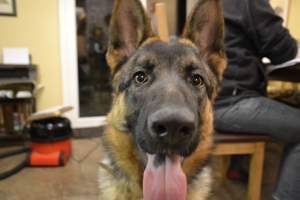Cynophobia – “An Irrational Fear of Dogs”
Many people out there think dogs are undoubtedly the best pets in the world, they cannot understand why people could not love them. But their are people out there who are more than afraid of dogs, they have a real fear of them.
The definition above is really rather off putting, it is not usually an “irrational” fear of dogs, but one based on experience. Having a negative reaction with dogs at a young age can put you off for life, with the increase in dog bites on children their is no doubt that their will be children growing up with a fear of dogs, so much so that they cannot be near them at all.
A fear of dogs can be based not on experience but on inexperience with them, some religions see dogs as dirty and do not interact with them. On the other hand those living in cities with low income might have no access to pets of any sort, and leave the children without experiencing dogs creating a fear out of ignorance.
The fear can also be influenced by the teaching of adults, often parents say not to touch dogs as they can be dangerous, they are not banning them from dogs but attempting to protect them from potential harm from that animal, this can lead to the child growing up having been told dogs are scary and dangerous, so they take it to heart and start to fear dogs based on pure comments.
The signs of fear include freezing, running away, shaking, sick feeling, as well as crying. The fear might be of only physical dogs, so watching Crufts doesn’t effect you but seeing a real dog on the street does. It can also be specific to a size of dog, usually large breeds.
Since dogs are so prevalent in society it can be difficult to avoid them, it might lead to being able to enjoy going to the park or visiting family. It can restrict routine and lead to depression from not being able to lead a normal life.
Their are two different methods that could be used, these are flooding and desensitization.
Flooding involves flooding the senses of the individual with the thing is fears, in this case dogs. This would mean making the person interact with dogs, to face their fears. It would also start with what they fear most. Making them confront the fear head on.
Desensitization would involve small steps, first interacting with a stuffed dog to learn how to control their behaviour and bodily changes learning coping strategies, then on to dogs at a distance decreasing the distance over several days or sessions. Then on to being near a calm and quiet dog, say in the same room. Eventually to being able to touch the dog, it will all climax into the loss of the fear of dogs. It is a long process but can aid most people in their fear of dogs. Their are more steps than described in this.
Other aids are therapy to understand the incident which caused the fear as well as addressing other emotional problems which could be adding to the stress of the situation. Medication could also be used to reduce stress and allow interactions to happen to aid in the recovery.
It is not to be mistake for breed specific fear, many people will cross the street if someone is walking a Staffordshire Bull Terrier, German Shepherd or Rottweiler, as they have been fed by media that they are dangerous and nasty dogs. This isn’t a fear of dogs, this is a reaction to media portrayal.
To fully deal with Cynophobia it needs to involvement of a behaviourist or dog handler and a therapist to be able to tackle the problem correctly.
Definition: http://www.thefreedictionary.com/cynophobia








 Would the feature of this breed make you think aggression or danger? For many that have no experience with dogs I am sure the answer is yes, but those with experience with the breed would tell you no. They are huge soft lumps, but can be trained to be more aggressive. Experience is involved in everything humans do, including the perception of canine companions.
Would the feature of this breed make you think aggression or danger? For many that have no experience with dogs I am sure the answer is yes, but those with experience with the breed would tell you no. They are huge soft lumps, but can be trained to be more aggressive. Experience is involved in everything humans do, including the perception of canine companions.

